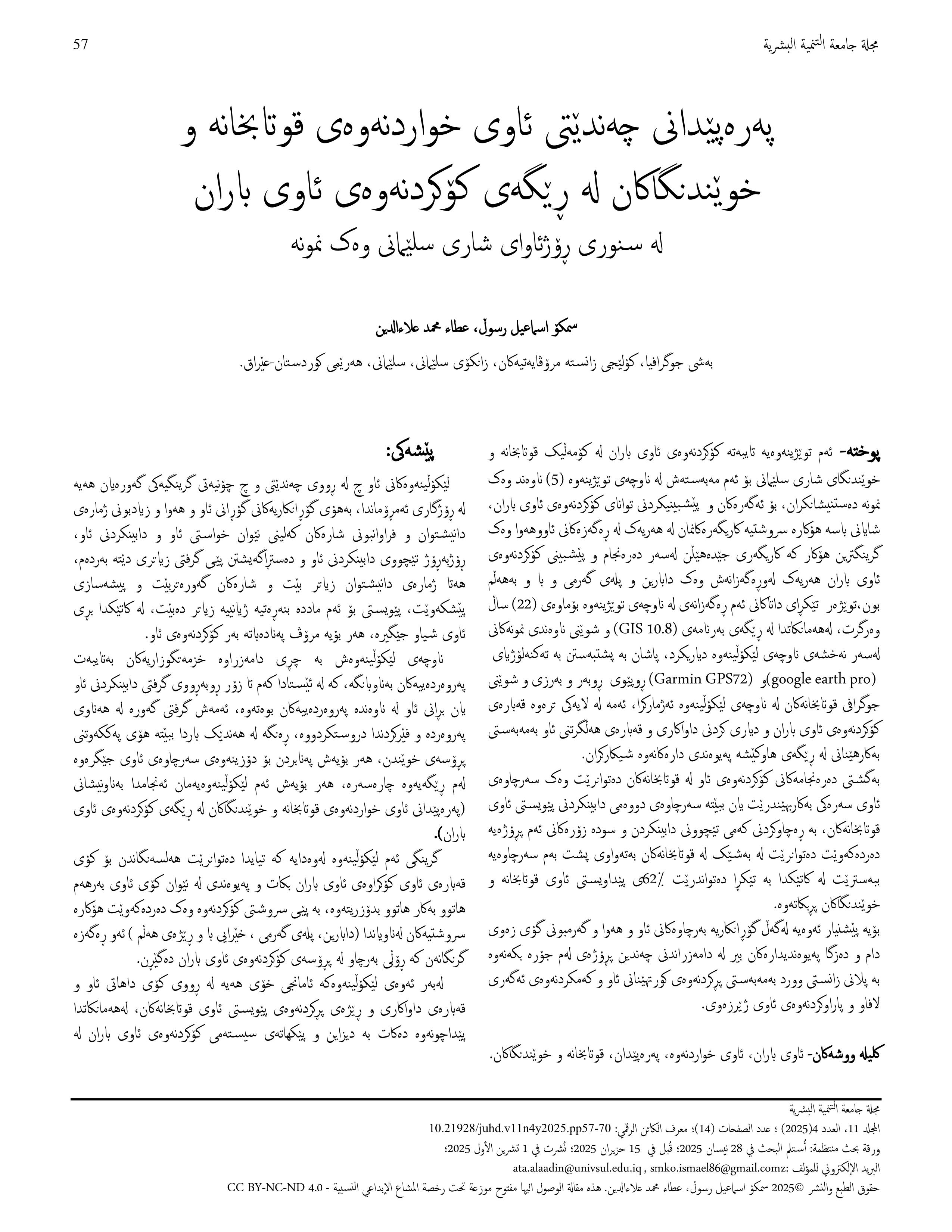Development the quantity of drinking water in schools through rainwater collection in the western of sulaimany, for example.
DOI:
https://doi.org/10.21928/juhd.v11n4y2025.pp57-70Keywords:
Rainwater, Drinking water, Development, Schools and schoolsAbstract
This study focuses on rainwater harvesting from a group of schools and institutes in Sulaymaniyah city. For this purpose, five centers were selected as samples in the research area. To analyze the possibilities and predict rainwater harvesting capacity, it is noteworthy that natural factors such as climate are among the most influential factors affecting the outcomes and predictions of rainwater harvesting. These factors include precipitation, temperature, wind, and evaporation. Data for these factors were collected in the research area over 22 years. Meanwhile, the central sample locations were mapped using GIS 10.8 software. Additionally, using Google Earth Pro and Garmin GPS72 technology, the area, elevation, and geographical location of the schools in the research area were calculated.
On the other hand, the volume of rainwater harvesting and the determination of water storage requirements and capacity for usage were analyzed through relevant equations.
Overall, the results of water harvesting in schools can be used as a primary water source or as a secondary source to meet the schools' water needs. Considering the low cost of implementation and the numerous benefits of this project, it is evident that some schools can fully rely on this source, while on average, it can meet 62% of the water demand for schools.
Therefore, it is recommended that, given the noticeable climate changes and global warming, relevant authorities should consider establishing multiple projects of this kind with a detailed scientific plan to address water scarcity, reduce flood risks, and recharge groundwater.position, in the sense that the choice of research paradigm takes precedence.
References
Adler, I. & C, L., 2009. community paricipation in decentralization rainwater system. water journal.
-AI, C. A. & N, S., 2009. Rainwater harvesting as an alternative water supply in the future. european journal, .
-Dragica Vujadinović, M. F. T. G., 2023. Gender-Competent Legal, Örebro: Springer Textbooks in law.
-Gharib, K. N., 2021. Rainwater harvesting assessment in sulaimani hights village. UHD JOURNAL OF SCINCE AND TEHNOLOGY, 5(1).
-G, S. C. & Reddy, R., n.d. Design construction and evaluation of rain water harvesting system. International .
-Hassell, C. & Thornton, J., n.d. Rainwater harvesting for toilet flushing in uk school.
-Islam, A., ALI, A., Aminur , R. & Azharul , I., 2019. Evaluation of harvested rainwater quality at primary school. Environ monitoring.
-Jay, G., Hina, b. & Parth, K., 2020. Designning roofop rainwater hervesting system at RK University, s.l.: Pharmacognosy and ohytochemistry.
-Jha, M. K. & Shah, N., 2015. Evaluating rainwater harvesting system for school buldings.
-John, A., Jamie, B., Yves, C. & Jackie , S., 2009. Water sanitation and Hygiene Standards for Schools in low-cost settings. s.l.:World Health Organization.
-Kelloger, R., 2011. rainwater harvesting for domestic water demand and storm water management. p. 83.
-Kim, Y. & Han, M., 2016. Community-based rain water harvesting to supply drinking water. water scince and technology.
-Morote, A. F., Hernandez, M., Oclina, J. & Rico, A. M., 2020. water consumption and management in schools in the city of alicante (Southern Spain). MDPI, Volume 1052.
-Ndiritu, J. G. & Carthy, S., 2014. Probabilistic assessment of the rain water hervesting potential of school in south Africa. Witwatersand.
-Nunes, L. G. & Soares, A. E., 2019. Water Consumption in public schools (a case study). water , Volume 119.
-Raimondi, A. & Abhijitih, G. R., 2023. Rainwater harvesting and treatment. MDPI.
-Rasyid, S. & Ardi, M., 2021. Rooftop rainwater harvesting (RRWH) for Schools. Alantic press.
-Rasyid, S., Ardi, m. & Lullulangi, M., 2022. Roofop rainwater harvesting for schools. Atlantis press, Volume 654.
-Snelling, A. m. & Lamonde, J., 2024. Public precipitaion of rain water harvesting.
-Sultan, R. & Muhammad, A., 2022. Rooftop Rainwater harvesting for schools. Atlantis press, Volume 654.
-Tembo, J. M. & Handia, L., 2003. Potential of rain water harvesting in urban zambia. journal physics and chemistry of the earh.
-Usman, I. & Mohammed, B. A., 2018. Assessing the potentials rainwater hervesing in college of environmental.
-Valenti, J., 2010. Washington Post. [Online]
Available at: https://www.washingtonpost.com/wp-dyn/content/article/2010/05/28/AR2010052802263.html?sid=ST2010052804193%E2%80%9D
[Accessed 06 09 2023].
-Zabidi, H. A. & Goh , H. W., 2020. A Review of roof and pond rain water harvesing system for water security. MDPI.
-Zhang, L. & Jiang, J., 2024. Optimizing ridge-furrow rainwater harvesting strategies for patato cultivation. agronomy.
پەروەردە, و., ٢٠٢٤-٢٠٢٥. ساڵنامەی خوێندن و تاقیکردنەوەکان.26 هەولێر: وەزارەتی پەروەردە.
عبداللە, ا. س., ٢٠٠٥. تایبەتمەندیەکانی باران لە هەرێمی کوردستان.27 سلێمانی: سەنتەری لێکۆڵینەوەی سراتیجی.
سلیمانی, س. ش., 2023. کارنامەی شارەوانی سلێمانی بڵاوکراوەی. -28 سەرۆکایەتی شارەوانی.
-29خورشید, ف. ح., 1971. الریاح و السوداء. 5-6 ed. s.l.: مجلة الشمس الکردستان.

Downloads
Published
How to Cite
Issue
Section
License
Copyright (c) 2025 Smko Ismael Rasool, Ata Muhammed Alaadin

This work is licensed under a Creative Commons Attribution-NonCommercial-NoDerivatives 4.0 International License.


